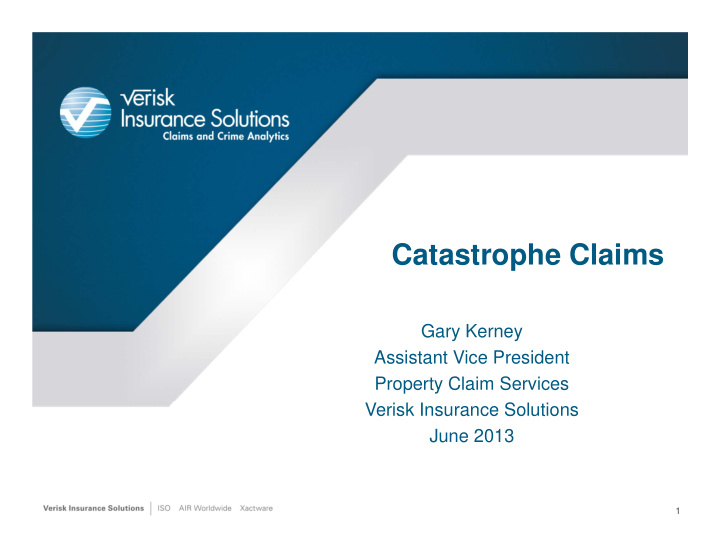



Catastrophe Claims Gary Kerney Assistant Vice President Property Claim Services Verisk Insurance Solutions June 2013 1
PCS • Since 1949, continuing a process begun in 1921 • Information provided to nearly 700 insurers, reinsurers, and others globally and to nearly 5,000 individual users. • Acknowledged worldwide as the source for insured catastrophe loss information in the US and Canada. • Extensive staff experience – 4 claims professionals with over 100 years of experience. 2
PCS Catastrophe Definition An event causing $25 million or more of insured property damage AND affecting a significant number of policyholders and insurers Same definition in use for the PCS-Canada service. 3
Catastrophes in the Last Decade Year Insured Loss Frequency 2003 $12,885,000,000 21 2004 $27,490,000,000 22 2005 $62,301,200,000 24 2006 33 $9,238,000,000 2007 23 $6,710,000,000 37 2008 $27,570,000,000 2009 $10,570,000,000 28 2010 $14,315,000,000 34 2011 30 $33,640,000,000 2012 26 $34,960,000,000 Total $239,154,200,000 278
Estimated Insured Loss by Storm Family: 1950 to 2012 $160,536,445,790 Hurricane (91) $159,607,646,208 Wind and Thunderstorm Event (1296) $27,536,207,409 Winter Storm $20,050,753,604 Fire – Other $13,964,150,000 Earthquake $7,657,348,000 Wildland Fire $4,734,320,000 Tropical Storm $970,250,000 Riot $300,000,000 Water Damage $180,000,000 Utility Service Disruption $27,000,000 Volcanic Eruption $387,664,121,011 Total Insured Loss (1,654)
Presentation of PCS Estimates Insured loss : Direct loss in US$, including ground-up, gross loss (gross of reinsurance but net of deductible and other limiting clauses), generally defined as the full or total insured property damage paid for by an insurer. PCS estimates do not include loss adjustment expense. Claim count : The number of claims received and anticipated for a particular event. Claims involving a single structure or insured that are layered among a number of insurers are counted by PCS as a single loss. (For example, PCS considered the World Trade Center complex to be one loss, even though coverage was provided by a number of insurers in various layers of a single program.) Personal lines losses : Involve homeowners, condominium unit owners, mobile-home owners, tenants policies covering structural, personal property, and time element (additional living expense) losses. Commercial lines losses : Include losses to commercial properties (retail, office, industrial), business personal property, time element (business interruption, contingent business interruption, extra expense), including buildings housing condominiums or apartment units. Vehicles : Includes both personal and commercial vehicles and insured losses covered by comprehensive coverage. (PCS does not include collision losses, such as those that may occur during a winter storm, in our estimates of catastrophe loss. PCS also does not include liability losses.) Workers Compensation 6
PCS Insured Loss Estimates • Included in PCS estimates: o Real property o Personal property o Time element losses o Vehicles (insured with comprehensive cover) o Boats o Certain inland marine coverages o Amounts paid by quasi public entities, e.g. Wind Pools 7
PCS Insured Loss Estimates • Not included in PCS estimates: o Loss above coverage limits (i.e. sump pump) o Deductibles – including HU or EQ Percentage Deductibles o Uninsured property – not calculated very well o Agriculture losses o Aviation losses o NFIP or WYO losses o Ocean marine o Loss Adjustment Expense 8
Catastrophes • 2013 Hurricane Forecasts Named Storms Hurricanes Major Hurricanes 2013 Forecast CSU 18 9 4 TSR 15 8 3 WSI 16 9 5 2013 Actual Seasonal 11 6 3 Average 9
Hurricane Sandy • CATASTROPHE SERIAL NO. 90 • DATES: October 28, 2012 To October 31, 2012 • STATES: Connecticut, Delaware, District of Columbia, Maine, Maryland, Massachusetts, New Hampshire, New Jersey, New York, North Carolina, Ohio, Pennsylvania, Rhode Island, Vermont, Virginia, West Virginia • PERILS: Flooding, Hurricane, Snow, Wind • STORM FAMILY: Hurricane Sandy • Connecticut $500,000,000 • District of Columbia $37,000,000 • Delaware $84,000,000 • Massachusetts $210,000,000 • Maryland $410,000,000 • Maine $36,000,000 • North Carolina $57,000,000 • New Hampshire $55,000,000 • New Jersey $6,300,000,000 • New York $9,600,000,000 • Ohio $292,000,000 • Pennsylvania $700,000,000 • Rhode Island $103,000,000 • Virginia $295,000,000 • Vermont $13,000,000 • West Virginia $58,000,000 • Total All States $18,750,000,000 10
Hurricane Sandy • Wind Field and Barometric Pressure o Wind gusts in coastal areas of 80 to 94 mph o Barometric Pressure measured in Atlantic City at 948.3mb – Wilma 954 mb • Flooding: o Bay v. Ocean o Saved by the Dunes o Inland Flooding • Wind • Power Outages • Hurricane Deductibles 11
Issues Affecting Response and Recovery (Some yet to come) • Power Outages (including gasoline pumps; two lines) • Access Issues – Ortley Beach and Hoboken, New Jersey • Damage to infrastructure – roads and bridges; Route 35 • Snow the next week • Rebuilding and Repair Issues o Winter weather o Availability of contractors o Availability of insurance or other money o Demand surge 12
Hurricane Sandy and Insurance • Business Interruption, Contingent Business Interruption, and Extra Expense Insurance o Power Outages • Off premises • Flooding • Food Spoilage o Downtown Manhattan • Subway tunnels • Basements • Streets o Oftentimes the coverage requires physical damage from an insured peril 13
Hurricane Sandy – Business Continuity • The impact of Sandy on business (The need for Flood or Excess Flood Insurance) o Retail o Hotels – cannot move o Businesses that cannot afford to be out of business (Extra Expense) • Stock brokers • Banks • Law Firms • Accountants o Restaurants o Marinas o Small Businesses on the Boardwalks o Fishing 14
Recommend
More recommend